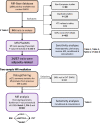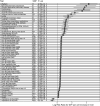A phenome-wide approach to identify causal risk factors for deep vein thrombosis
- PMID: 37951941
- PMCID: PMC10640748
- DOI: 10.1186/s12920-023-01710-9
A phenome-wide approach to identify causal risk factors for deep vein thrombosis
Abstract
Deep vein thrombosis (DVT) is the formation of a blood clot in a deep vein. DVT can lead to a venous thromboembolism (VTE), the combined term for DVT and pulmonary embolism, a leading cause of death and disability worldwide. Despite the prevalence and associated morbidity of DVT, the underlying causes are not well understood. Our aim was to leverage publicly available genetic summary association statistics to identify causal risk factors for DVT. We conducted a Mendelian randomization phenome-wide association study (MR-PheWAS) using genetic summary association statistics for 973 exposures and DVT (6,767 cases and 330,392 controls in UK Biobank). There was evidence for a causal effect of 57 exposures on DVT risk, including previously reported risk factors (e.g. body mass index-BMI and height) and novel risk factors (e.g. hyperthyroidism and varicose veins). As the majority of identified risk factors were adiposity-related, we explored the molecular link with DVT by undertaking a two-sample MR mediation analysis of BMI-associated circulating proteins on DVT risk. Our results indicate that circulating neurogenic locus notch homolog protein 1 (NOTCH1), inhibin beta C chain (INHBC) and plasminogen activator inhibitor 1 (PAI-1) influence DVT risk, with PAI-1 mediating the BMI-DVT relationship. Using a phenome-wide approach, we provide putative causal evidence that hyperthyroidism, varicose veins and BMI enhance the risk of DVT. Furthermore, the circulating protein PAI-1 has a causal role in DVT aetiology and is involved in mediating the BMI-DVT relationship.
Keywords: ALSPAC; Deep vein thrombosis; Genome-wide association study; Mendelian randomization; Protein quantitative trait loci.
© 2023. The Author(s).
Conflict of interest statement
The authors declare no competing interests.
Figures




References
-
- Heart Disease and Stroke Statistics-2021 Update A Report from the American Heart Association. Lippincott Williams and Wilkins; 2021. - PubMed
-
- ONS. Mortality statistics. Official Labour Market Statistics 2020.
Publication types
MeSH terms
Substances
Grants and funding
LinkOut - more resources
Full Text Sources
Medical
Research Materials
Miscellaneous

